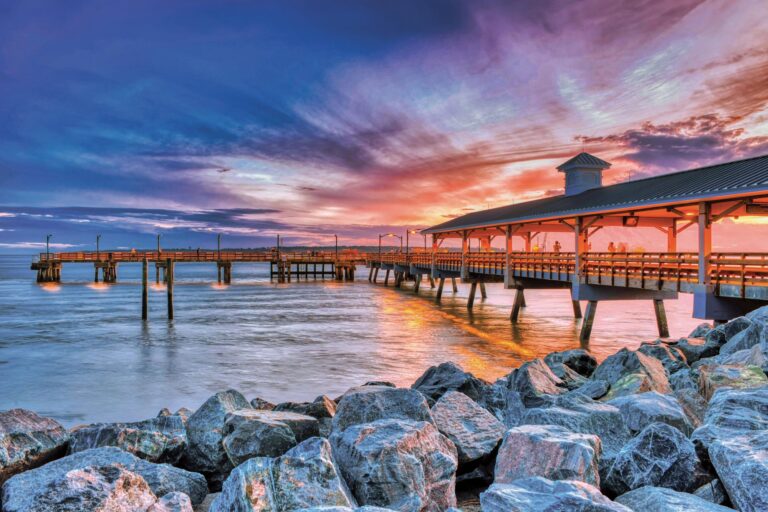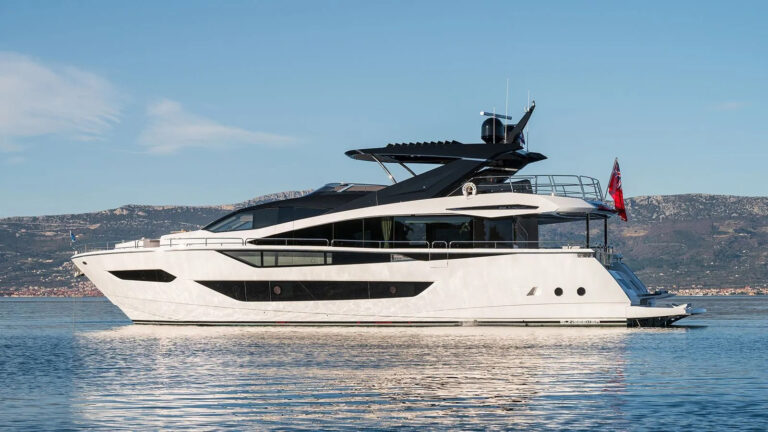Every boat is a compromise. Aesthetics are compromised for interior volume. Performance is compromised for amenities. Comfort is compromised to accommodate the masses. The Nordhavn 35 Coastal Pilot’s developers threw that notion into the howling Pacific wind by whittling the design brief. They set out to build a well-equipped boat for a couple to cruise comfortably around 12 knots in coastal regions with a single engine that could handle a few extended jaunts. The only other requirement: Build her like a ship. The simple goals and manner of execution make the 35 a special soul.
Her interior has three areas: pilothouse/saloon, galley/head and master cabin. Because the boat was designed for two, not a family of six and their French poodle, one area is not compromised for the sake of another.
The saloon is devoted to living in and running the ship. An L-shape settee to port is elevated to allow visibility through the front, side and rear windows. A TV cabinet is at the foot of the settee, which forms a berth that’s 6 feet, 6 inches long and 48 inches wide-a cozy double or big single. For those who still like to mark their position with a little X, a drawer under the settee base can swallow a stack of Admiralty charts.
On hull number one, the space opposite the settee was intended for a recliner, several shelves and lockers. It resembled an ill-fitted puzzle. Another buyer specified a straight settee, which likely will fit better. The area was tweaked on subsequent 35s, a practice for which Nordhavn is known. The builder always takes hull number one, said Jeff Merrill, Coastal Pilot project manager. “We’re running the boat all the time and learn on ourselves,” he said.
The helm will absorb all necessary cruising gadgets. A double helm seat to starboard has plenty of drawers and nooks underneath. A platform and outlet forward of the helmsman accommodate the ship’s laptop. I would suggest adding night lights in the main saloon and galley area to reduce glare. Docking should be straightforward, aided by a side-opening window at the helm, a good 360-degree line of sight and a Side Power 4 hp bow thruster.
Depth and color are consistent throughout the main saloon teak, which is built from the same log. The same level of finish exists behind fiddles and drawers, and inside lockers.
The U-shape galley, four steps down, is finished with Formica bulkheads and teak trim. “We wanted to avoid feeling like you were stepping into a dark hole,” Merrill said. Although Nordhavn calls this boat a Coastal Cruiser, there is enough galley stowage for an extended offshore Alaskan adventure. Two top-loading stowage bins, four 9-inch-wide by 21-inch-deep drawers, a pot and pan drawer under the range and kitchen-like overhead cabinets provide more space than most Manhattan apartments. I would get the optional trash compactor instead of the four 13-inch-wide by 22-inch-deep drawers. Merrill and I agreed the optional washer/dryer combination unit inside a pantry opposite the galley was good for washing but inadequate for drying. An overhead Lewmar hatch provides fresh breezes. Sandstone-colored vinyl nonslip sole covers the galley and passageway.
Opposite the galley, the head’s layout maximizes space. An electric Jabsco MSD uses fresh water to minimize odor, a five-minute timer eliminates the risk of frying your sump pump, an exhaust blower removes moisture and odor, and an opening port in the 26-by-28-inch shower stall provides light and air.
The arrangements plan of the owner’s cabin fails to reveal the cabin’s space and functionality. A large athwartships berth measures between 6 feet, 3 inches long and 6 feet, 9 inches long with a width of 5 feet. This stateroom is close to ideal for any 35-foot boat, with nightstands on both sides, reading lights, his-and-her hanging lockers, a seat, a teak and spruce sole, a Lewmar opening port, side opening ports and dorade vents.
Folks at Nordhavn really cruise their boats. (I chuckled the night before my test when I spotted Pacific Asian Enterprises principal Jim Leisham washing the boat, gazing at his creation like an admiring father.) The bluewater experience is apparent in the engineroom. Access from the galley is through a 3-inch-thick, insulated fiberglass door with dogs and an inspection port. An aluminum fuel reservoir is below the lowest point of the fuel tanks and is gravity-fed. A drain plug at the bottom evacuates sediment buildup in the fuel tanks and purges water. A 1-gallon sight gauge lets you check fuel consumption by shutting off the supply lines from the tanks and monitoring the gauge as fuel is consumed from the reservoir.
Our test boat had a 350 hp Yanmar 6LYA-STE diesel mounted on the centerline. All service points were to starboard for easy access, as were the dual Racor filters. You can squeeze to the engine’s port side, but it is tight.
The lazarette is huge. An 11-gallon hot water tank, an inverter, optional air-conditioning compressors and two 8-D house batteries are outboard, allowing basement-like space for gear. If you choose the electric range, the propane locker next to the lazarette becomes another deep stowage locker.
Still, what sets the Coastal Pilot apart from other Nordhavns is not the attention to detail, extensive equipment and quality construction. It’s the semi-displacement hull design. Extensive tank testing was used to develop a hull with a soft-V entry and a deep forefoot that transitions into a full-length keel and reduces pounding in a head sea. A bronze carrier extends from the bottom of the keel to support the rudder and protect the prop. The beam is carried well aft. Combined with round bilges and soft chines aft, the positioning will minimize roll.
When enough horsepower is applied, the Coastal Pilot begins to plane on her aft chines. Her bow lifted slightly as we increased rpms, and the stern lifted as we pushed the throttle forward. The after section of the underbody incorporates a wedge that kept the trim angle down, essentially acting as trim tabs as we increased speed. We hit a top speed of 11.8 knots, at which the Coastal Pilot has about a 440-nautical mile range, according to Nordhavn. At speed, sound at the helm was 82 decibels. “We hope to achieve a reading in the 70 range on the next hulls,” Merrill said.
If it appears I liked the Nordhavn, well, I did. What’s not to like about a company full of uncompromising boat nuts who constantly strive to improve their product?
Contact: Pacific Asian Enterprises, (949) 496-4848; fax (949) 240-2398; www.nordhavn.com.









